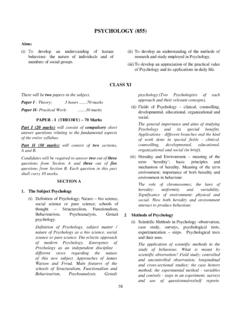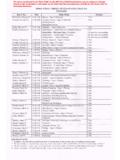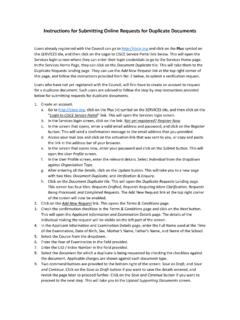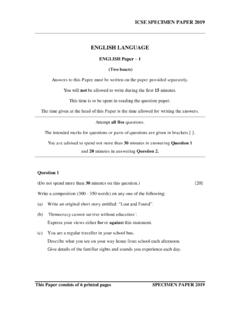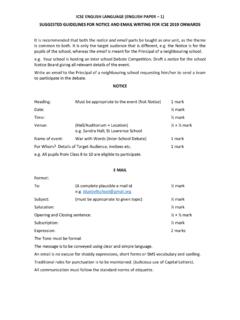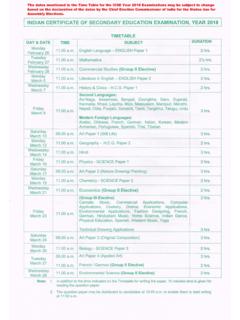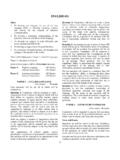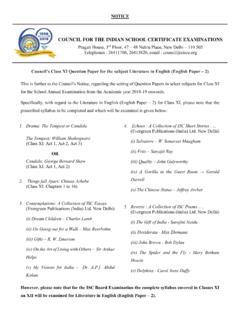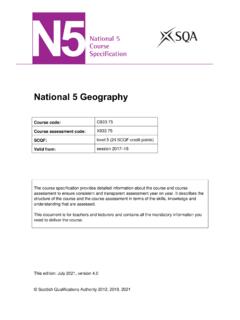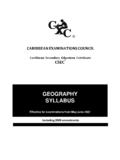Transcription of HISTORY, CIVICS AND GEOGRAPHY (50)
1 HISTORY, CIVICS AND GEOGRAPHY (50). GEOGRAPHY . - Paper - 2. Candidates offering History, CIVICS and GEOGRAPHY (Thailand) are not eligible to offer History, CIVICS and GEOGRAPHY . CLASS X. There will be one paper of two hours duration (f) Identify: Site of prominent villages and/or carrying 80 marks and Internal Assessment of towns, types of occupation and means of 20 marks. communication with the help of the index given at the bottom of the sheet. The Paper will consist of two parts, Part I and Part II. (g) Identification of drainage patterns (Dendritic, Part I (compulsory) will consist of two questions.)
2 Trellis, Radial, and Disappearing) and Question 1 will be based on Topographical Map. settlement patterns (Scattered and Compact). Question 2 will be based on outline Map of India. Identification of direction of flow, left bank and right bank of a river. Part II: Candidates will be expected to answer any five questions. (h) Identification of natural and man-made features. Candidates will be expected to interpret/make the fullest use of sketches, diagrams, graphs and charts in (i) Meaning of important terms- Relative height /. depth, broken ground, surveyed tree, fireline, their answers. causeway, aqueduct and diggi.
3 Questions set may require answers involving the interpretation of photographs of geographical 2. Map of India interest. On an outline map of India, candidates will be PART I required to locate, mark and name the following: MAP WORK. Mountains, Peaks and Plateaus: Himalayas, 1. Interpretation of Topographical Maps Aravali, Vindhyas, Satpura, Western and (a) Locating features with the help of a four- Eastern Ghats, Nilgiris, Mount figure grid reference. Kanchenjunga. Deccan Plateau, Chota (b) Definition of contour and contour interval. Nagpur Plateau. Identification of landforms marked by contours (steep slope and gentle slope), Plains: Gangetic Plains and Coastal plains.
4 Triangulated height, spot height and (Konkan, Malabar, Coromandel). benchmark. Desert: Thar (The Great Indian Desert). (c) Interpretation of colour tints used on a Rivers: Indus, Jhelum, Satluj, Ganga, topographical survey of India map. Yamuna, Kosi, Chambal, Betwa, (d) Identification and definition of types of scale Brahmaputra, Narmada, Tapti, Mahanadi, given on the map. Godavari, Krishna, Cauveri, Tungabhadra. Measuring direct distance and calculating area using the scale given therein. Water Bodies: Gulf of Kutch, Gulf of (e) Marking directions between different Khambhat, Andaman Sea, Chilka Lake.
5 Locations, using eight cardinal points. Pass: Karakoram. 1. Longitude: Standard Meridian (82 30'E). 6. Natural Vegetation Direction of Winds: South West Monsoons Importance of forests. (Arabian Sea and Bay of Bengal Branches), Types of vegetation (tropical evergreen, North East Monsoons. tropical deciduous, tropical desert, littoral and mountain), distribution and correlation Distribution of Minerals: Oil - Mumbai High with their environment. (Offshore Oil Field), Coal Jharia. Forest conservation - meaning and methods Soil Distribution Alluvial and Black Soil. (afforestation, reafforestation, social forestry, Cities - Delhi, Mumbai, Kolkata, Chennai and and farm forestry).
6 Allahabad. 7. Water Resources Population - Distribution of Population Sources (Surface water and ground water). (Dense and sparse). Need for conservation and conservation PART - II practices (Rain water harvesting and its importance). GEOGRAPHY OF INDIA. Irrigation: Importance and methods (wells, 3. Location, Extent and Physical features canals, tanks, drip irrigation, sprinkler irrigation - area, conditions and advantages). Position and Extent of India. (through Map only). 8. Mineral and Energy Resources The physical features of India mountains, Iron ore, Manganese, Copper uses and their plateaus, plains and rivers.
7 (through Map distribution. only). Conventional Sources: Coal, Petroleum, 4. Climate Natural gas (distribution, advantages and disadvantages). Distribution of Temperature, Rainfall, winds in Hydel power (Bhakra Nangal Dam and Summer and Winter and factors affecting the Hirakud) location and State benefitted. climate of the area. Monsoon and its mechanism. Seasons: March to May Summer; June to Non-conventional Sources: Solar, wind, September Monsoon; October to November - nuclear and biogas (location and Retreating Monsoon. December to February advantages). Winter. Study of climatic data. 9. Agriculture 5.
8 Soil Resources Indian Agriculture importance, problems and reforms. Types of soil (alluvial, black, red and laterite). Agricultural seasons (rabi, kharif, zayad). distribution, composition and characteristics such as colour, texture, minerals and crops Climatic conditions, soil requirements, associated. methods of cultivation, processing and distribution of the following crops: Soil Erosion meaning, agents (water and wind), types (sheet and gully erosion) causes. - rice, wheat and pulses. - Sugarcane and oilseeds (groundnut and Soil conservation - Meaning and methods mustard). (terrace farming, crop rotation, planting of - Cotton and tea.)
9 Shelter belts and afforestation). 2. 10. Manufacturing Industries 4. Transport in India: Importance and classification Development of Road, Rail, Water and Air Agro based Industry - Sugar, Textile (Cotton). routes. Mineral based Industry Iron & Steel (Tata 5. List different type of industries in the States and Steel, Rourkela), Petro Chemical and collect information about the types of raw Electronics. materials used, modes of their procurement and disposal of wastes generated. Classify these 11. Transport industries as polluting or environment friendly Importance and Modes Roadways (National and and suggest possible ways of reducing pollution State highways, Golden quadrilateral, NSEW caused by these units.
10 Corridor), Railways, Airways and Waterways - 6. Need for industrialization in India, the latest trends Advantages and disadvantages. and its impact on economy of India. 12. Waste Management 7. Visit a water treatment plant, sewage treatment Need for waste management. plant or garbage dumping or vermicomposting sites in the locality and study their working. Methods of safe disposal - segregation, dumping and composting. EVALUATION. Need and methods for reducing, reusing and The assignments/project work is to be evaluated by the recycling waste. subject teacher and by an External Examiner. (The External Examiner may be a teacher nominated by the Head of the school, who could be from the faculty, but INTERNAL ASSESSMENT.
